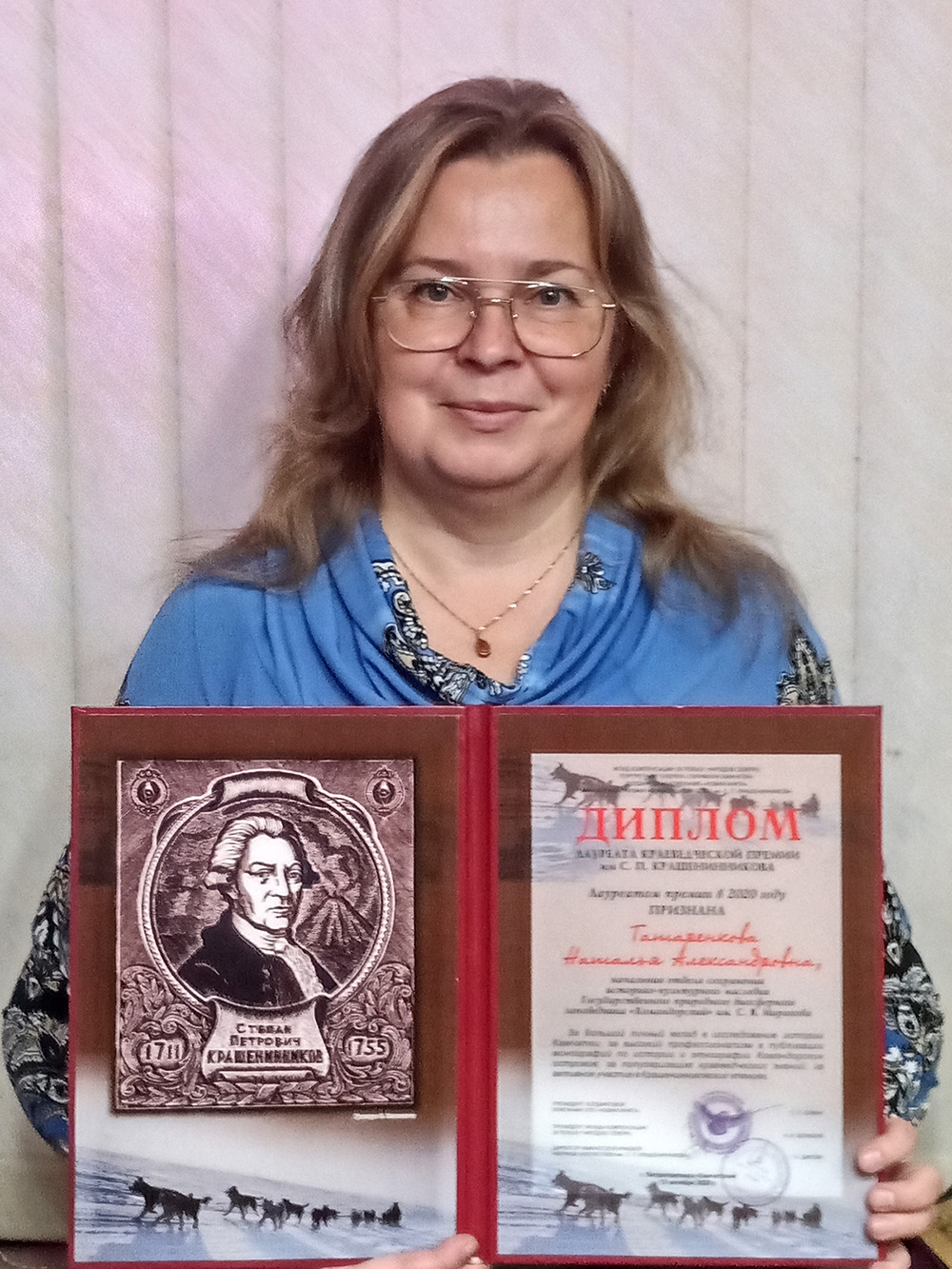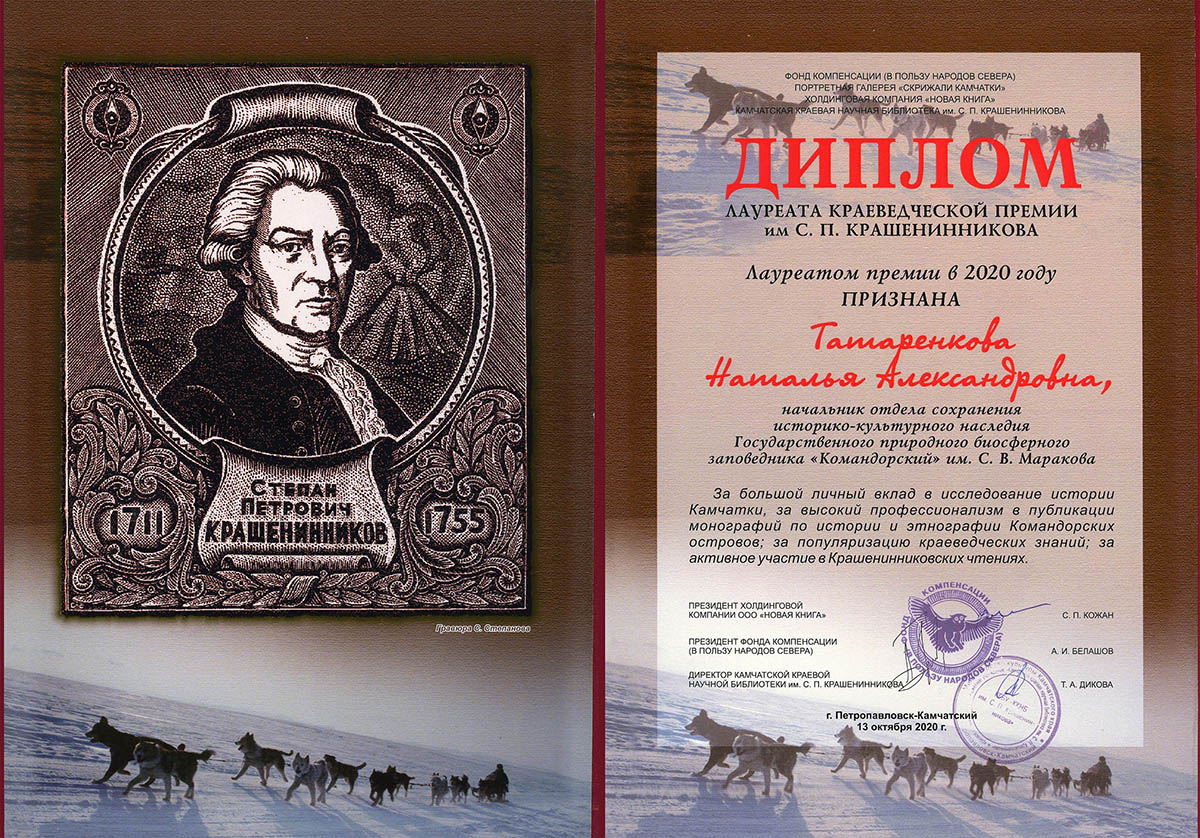Natalya Tatarenkova, Head of Historical and Cultural Heritage Department of the Commander Islands Nature and Biosphere Reserve, became a laureate of Krasheninnikov S.P. Kamchatka Regional Studies Award.The ceremony took place on October 15 at Kamchatka Regional Scientific Library in the framework of the XXXVI Krasheninnikov Readings with the general thematic title "We are proud of the glory of our ancestors...". This year the event is dedicated to the 75th anniversary of Victory in the Great Patriotic War and the 280th anniversary of the founding of Petropavlovsk-Kamchatsky.
On behalf of the Novaya Kniga Holding Company, the Compensation Fund (in favor of indigenous peoples of the North) and the regional library, Tatyana Dikova noted the great personal contribution of Natalia Tatarenkova to the study of the history of Kamchatka, her high professionalism in the publication of monographs on the history and ethnography of the Commander Islands and thanked for many years of work on raising awareness about local lore and active participation in the Readings.
Laureate of S.P. Krasheninnikov Regional Studies Award Natalya Aleksandrovna Tatarenkova
The first block of reports was dedicated to the 75th anniversary of the victory in the Second Warld War.The second one shares reports of various kind. Natalya Tatarenkova made a presentation “Genealogy and biographies of the Commander Islands Aleuts". Genealogy is a fairly exact science that does not tolerate subjectivity. Over the past five years, the author has compiled primary genealogical tables for all basic Aleutian families that lived on the Commanders in the 19th-20th centuries. These include common surnames: Badayevs, Berezins, Golodovs, Grigorievs, Ladygins, Popovs, Stepnovs, Sushkovs, Udachins, Yakovlevs and the few: Artamonovs, Kichins, Proshevs, Sinitsins, Khabarovs. Remaining on hearing: Aksyonovs, Budakovs, Burdukovskys, Volokitins, Galkins, Durishins, Zaikovs, Korsakovs, Maltsevs, Myakishevs, Nozhikovs, Pankovs, Pakhomovs, Snegirevs, Startsevs, Horoshevs, Shipitsyn and the forgotten ones: The Yeranskys, Ivanovs, Kadins, Katynchak, Kaurovs, Kontuyak-Seleznevs, Losevs, Kulikalovs, Mershenins, Nevzorovs, Nikolaevs, Holgins, Pesenkovs (Pishenkovs), Stepanovs, Khudyakovs, Shadrovs, Shangins-Pazhuk, Yurievs.And also new ones: Bulannikovs, Volkovs, Vozhikovs, Debushevskys, Dobrynins, Kiyaykins, Korolevs, Kuznetsovs, Kuzmins, Petrovs, Stroganovs, Timonkins, Timoshenko, Tyuterevs and others. The materials are based on documents from the times of the Russian-American Company, birth records, confessions and family lists of the late 19th century, documents from the Soviet period, and rich field material.
.jpeg)
Participants of the XXXVI Krasheninnikov Readings
Genealogical charts clearly illustrate the resettlement of each of the family members from one island to another, to Kamchatka or to another region. Tracking migration routes allows you to look differently at the social processes that took place on the Commanders in the 19th - first half of the 20th centuries. The very process of settling the islands looks different. The study of genealogy helps in finding answers to many key questions: about the formation of economic systems and types of nature management at different stages of territory development; on the ratio of traditional and imported elements; on the reasons for the existence of certain objects of material and non-material culture; about the peculiarities of the formation of two distinct dialects of the Bering and Medny islands, etc. Genealogy is a “skeleton” that, in the skillful hands of a local historian, “develops” real stories and facts.
These materials are used in the compilation of almost every text of local lore, be it toponymy, traditional use of natural resources or the study of everyday objects. They helped to recreate the history of the first settlers, to reveal the secret of the "Commander Kuril", to restore the picture of the seizure of the village of Nikolskoye and the Northern fur seal rookery during the Russian-Japanese war of 1905, and much more.Thanks to the accumulated data on visual anthropology (going side by side with genealogy), two portrait dolls "Aleutian Man and Aleutian Woman", reflecting the life of the late 19th century, were made this year.
A lot has already been done, but "blank spots" remain.Investigations are ongoing.










